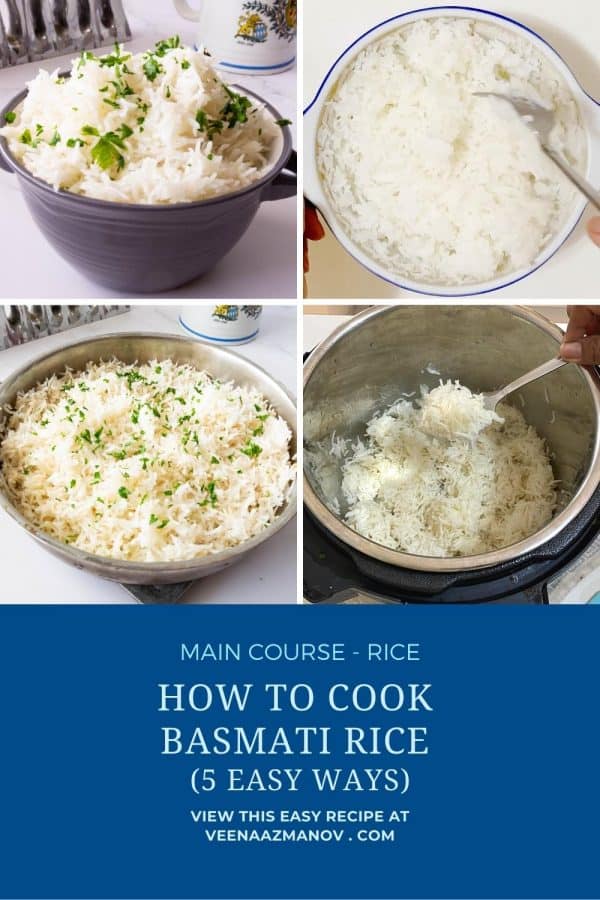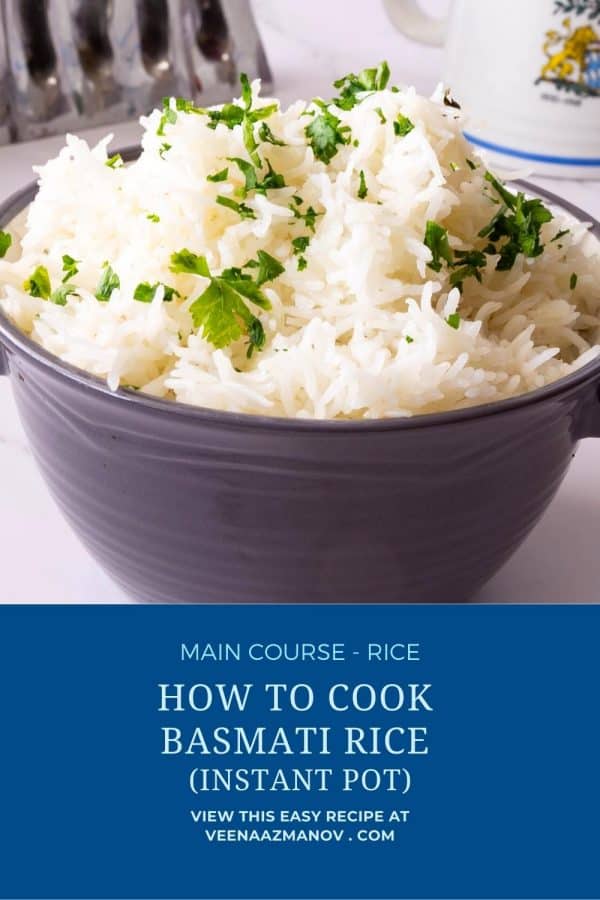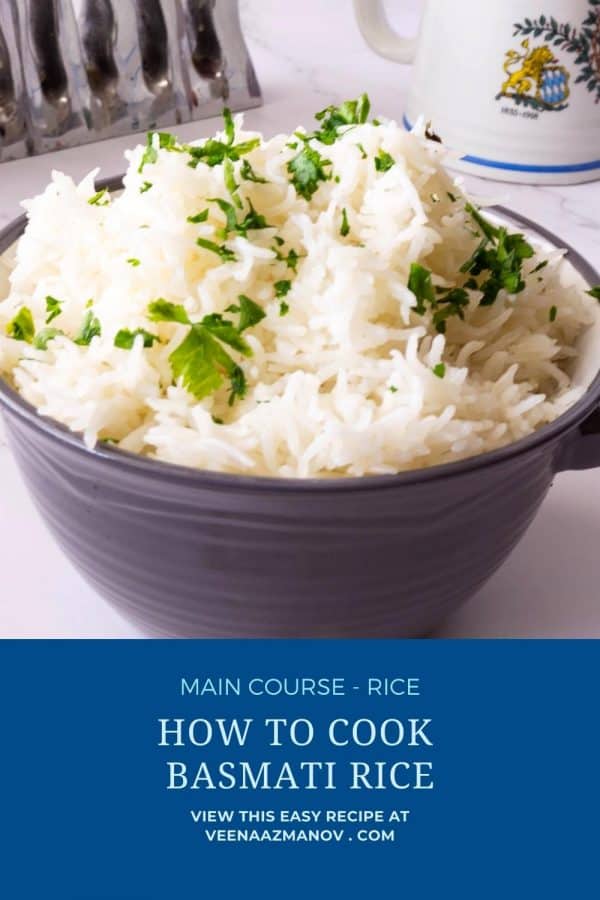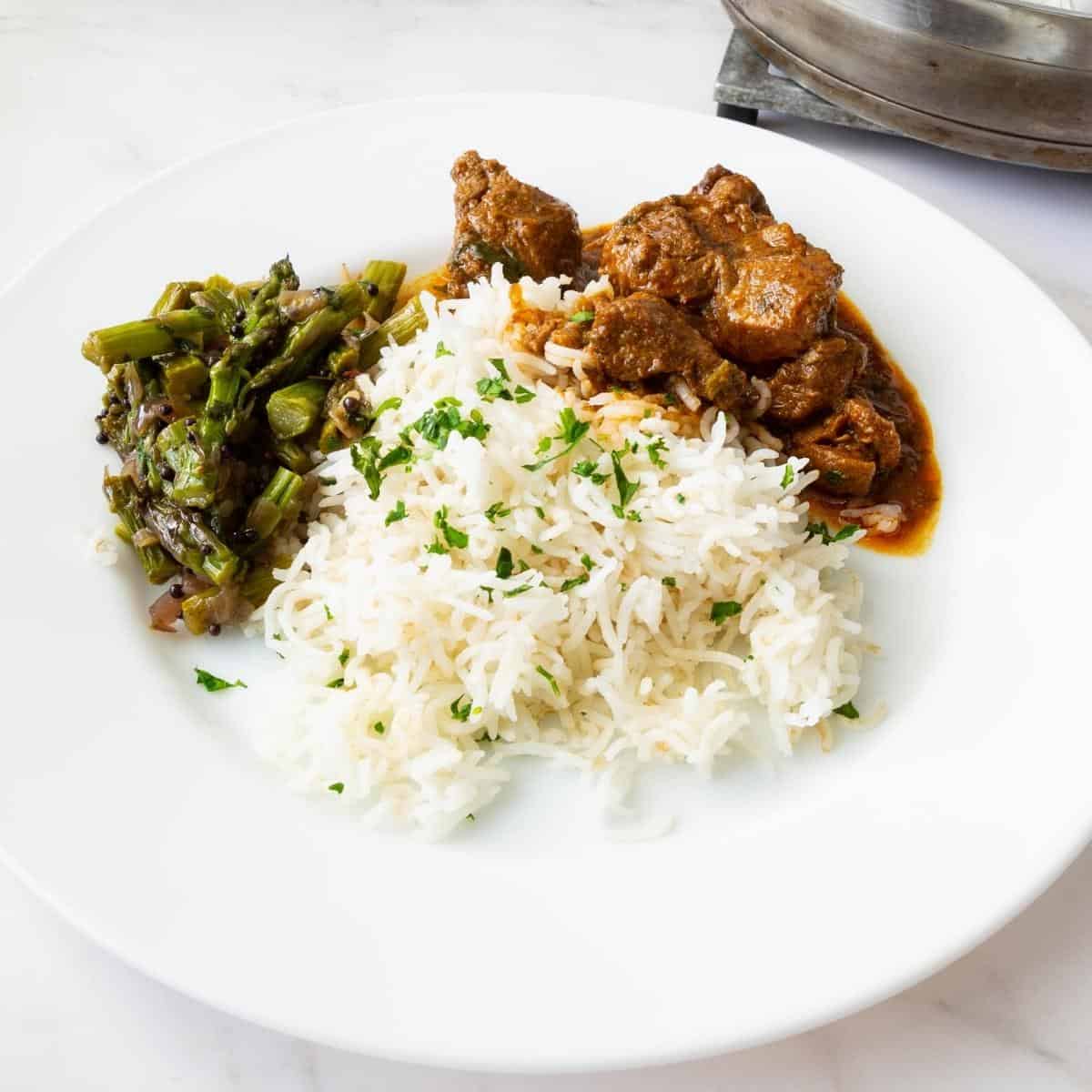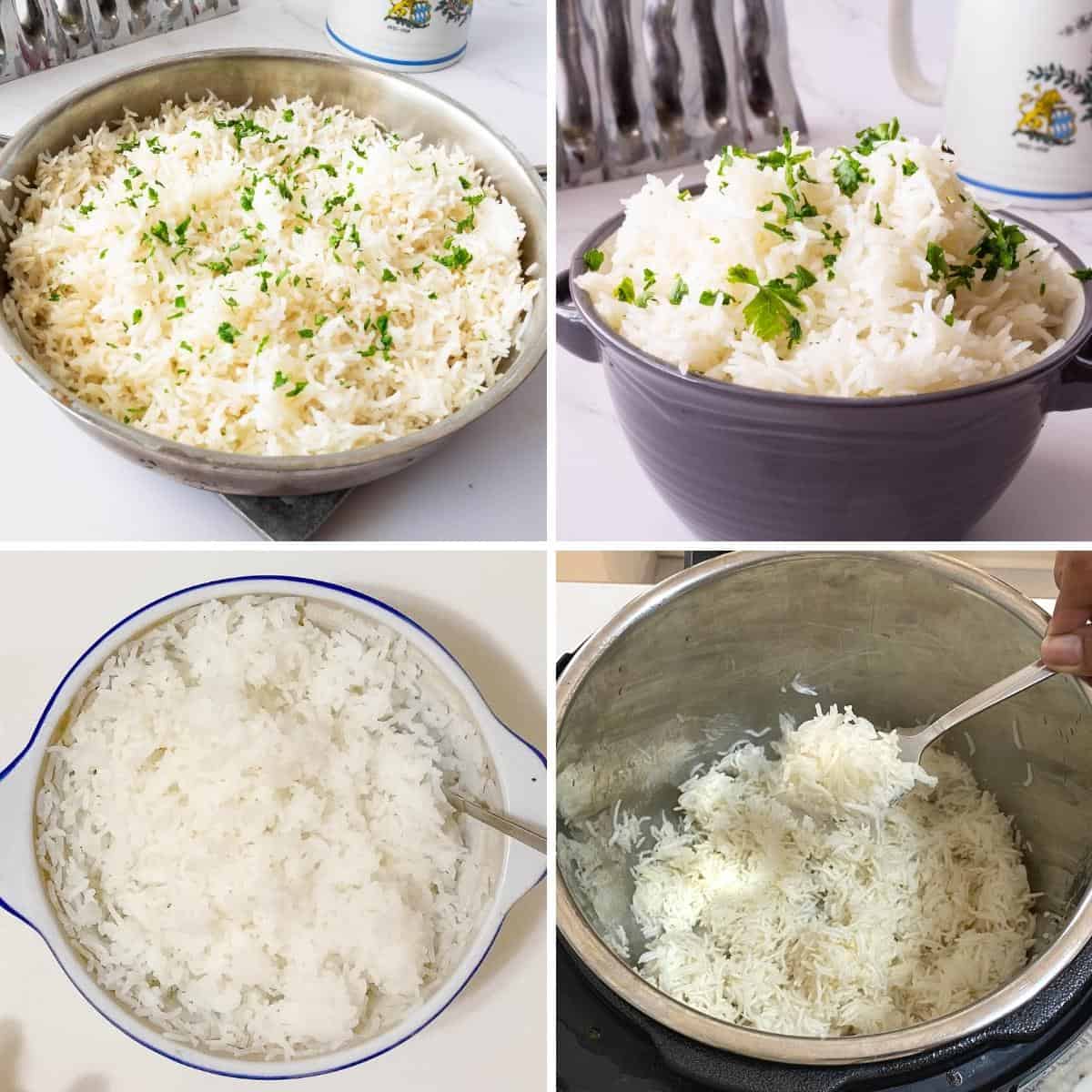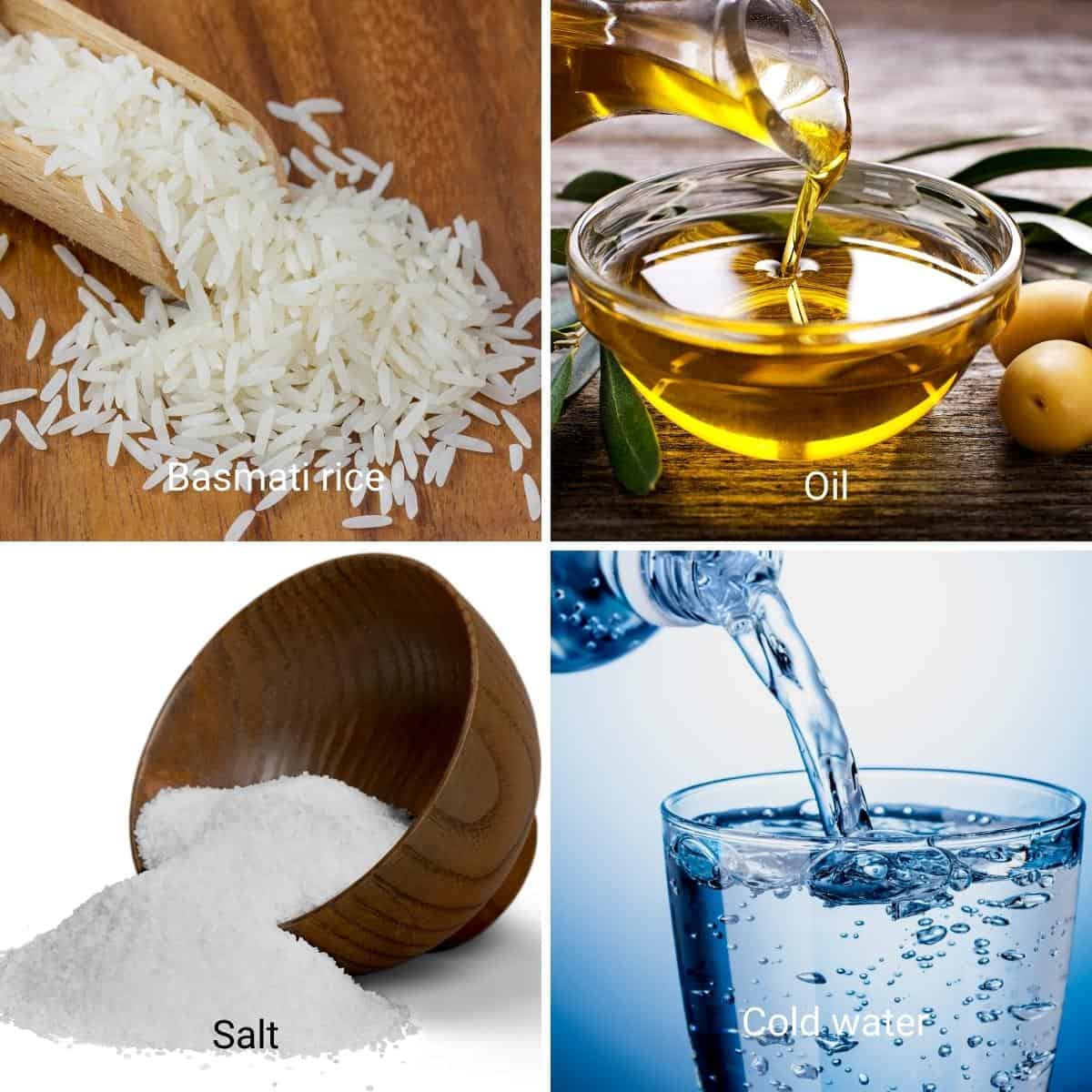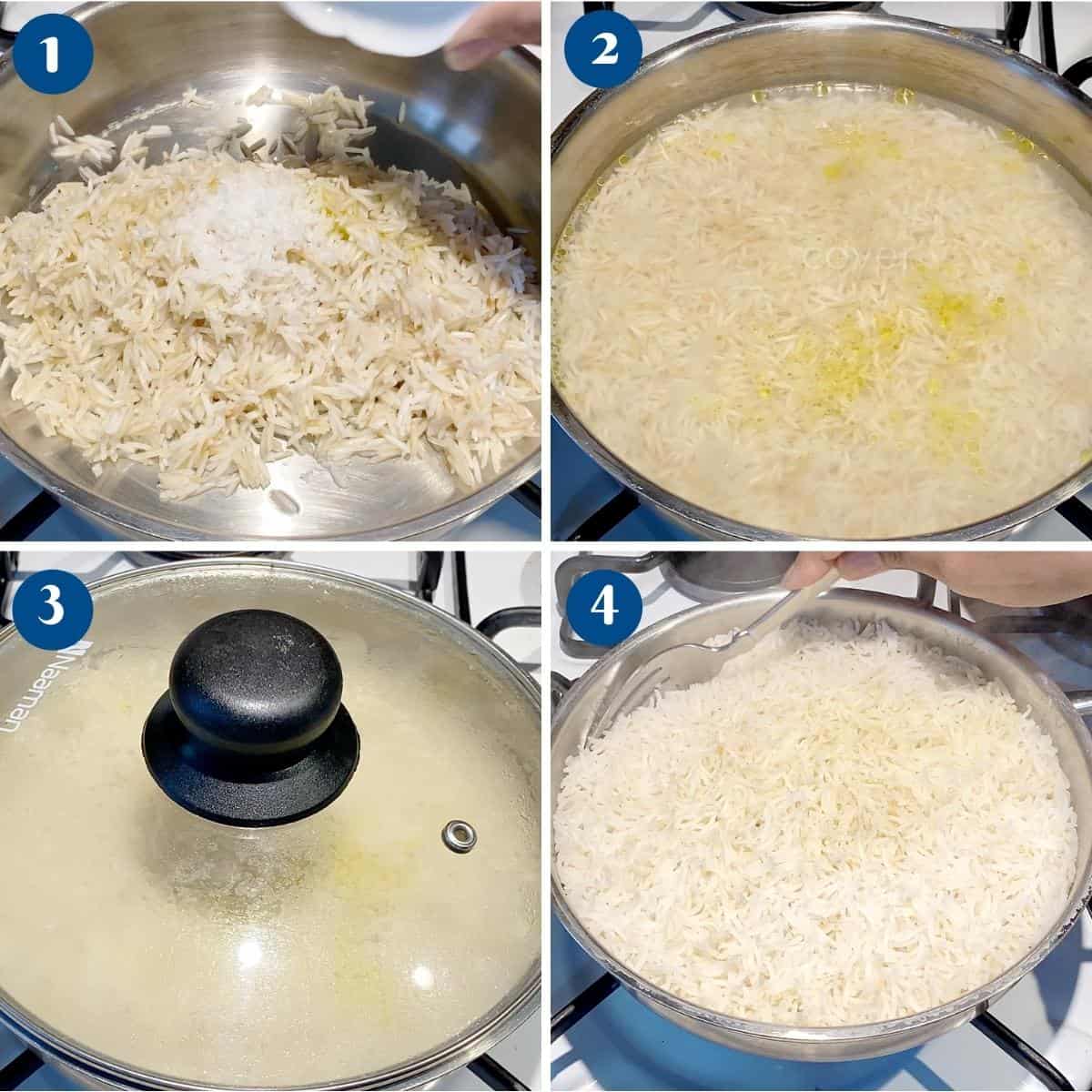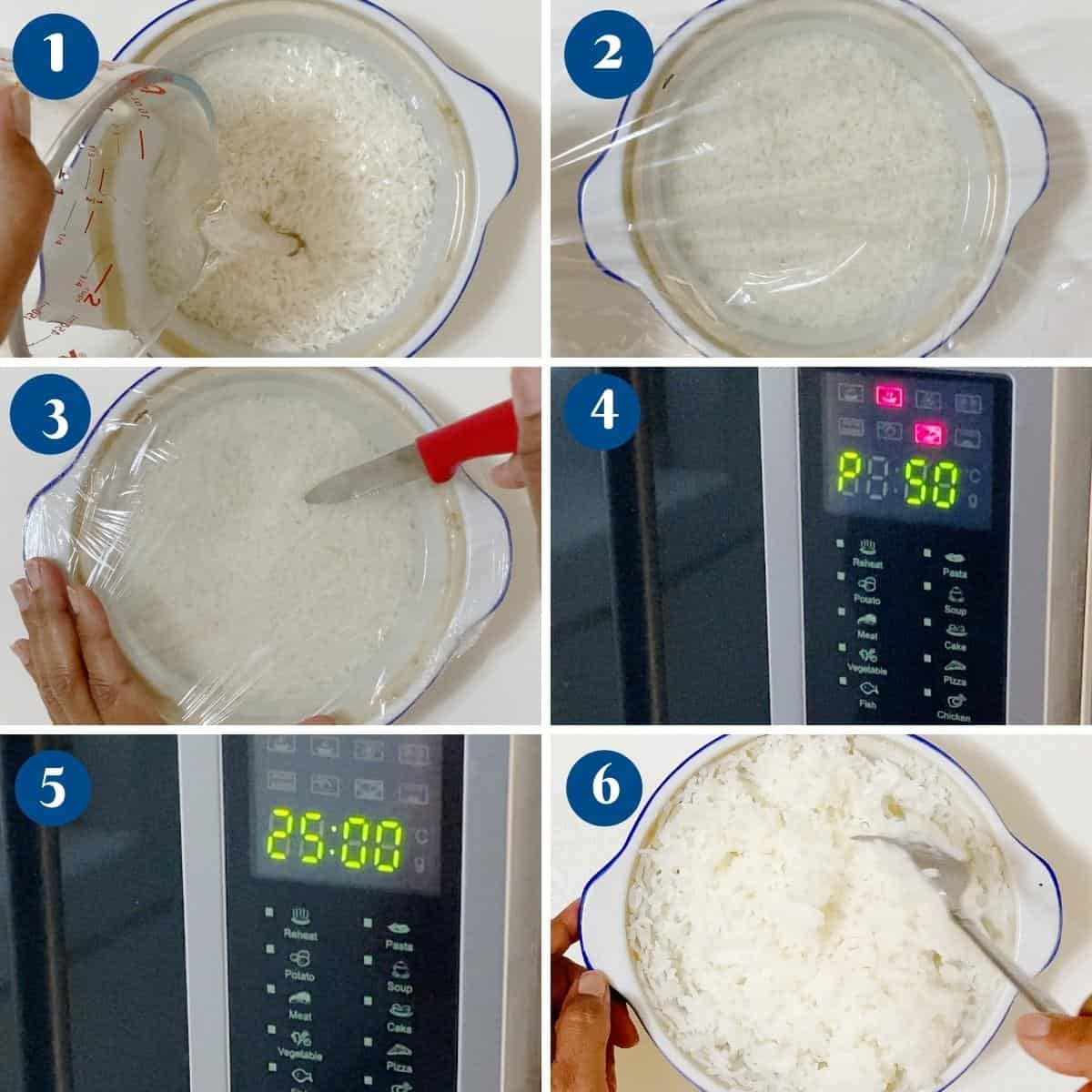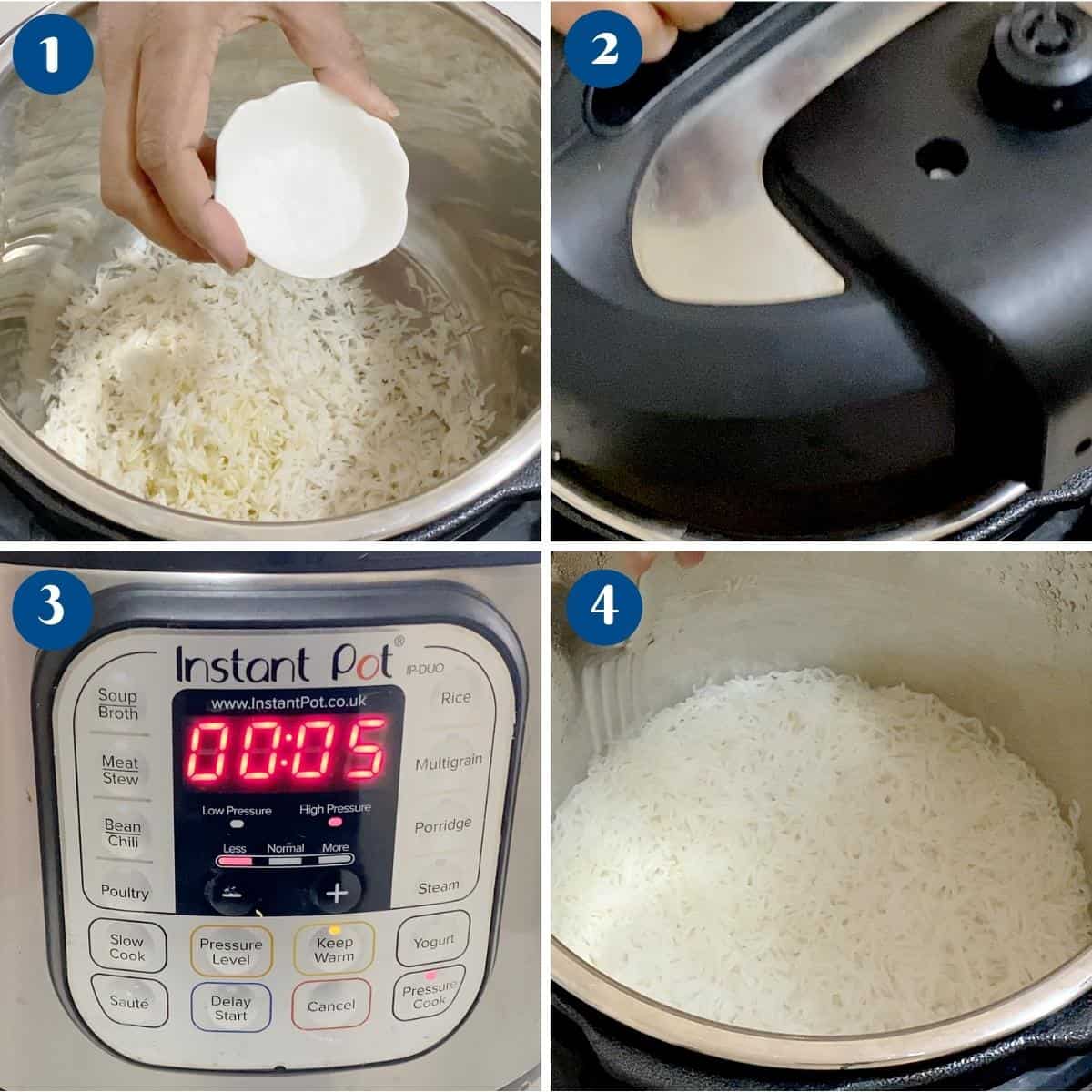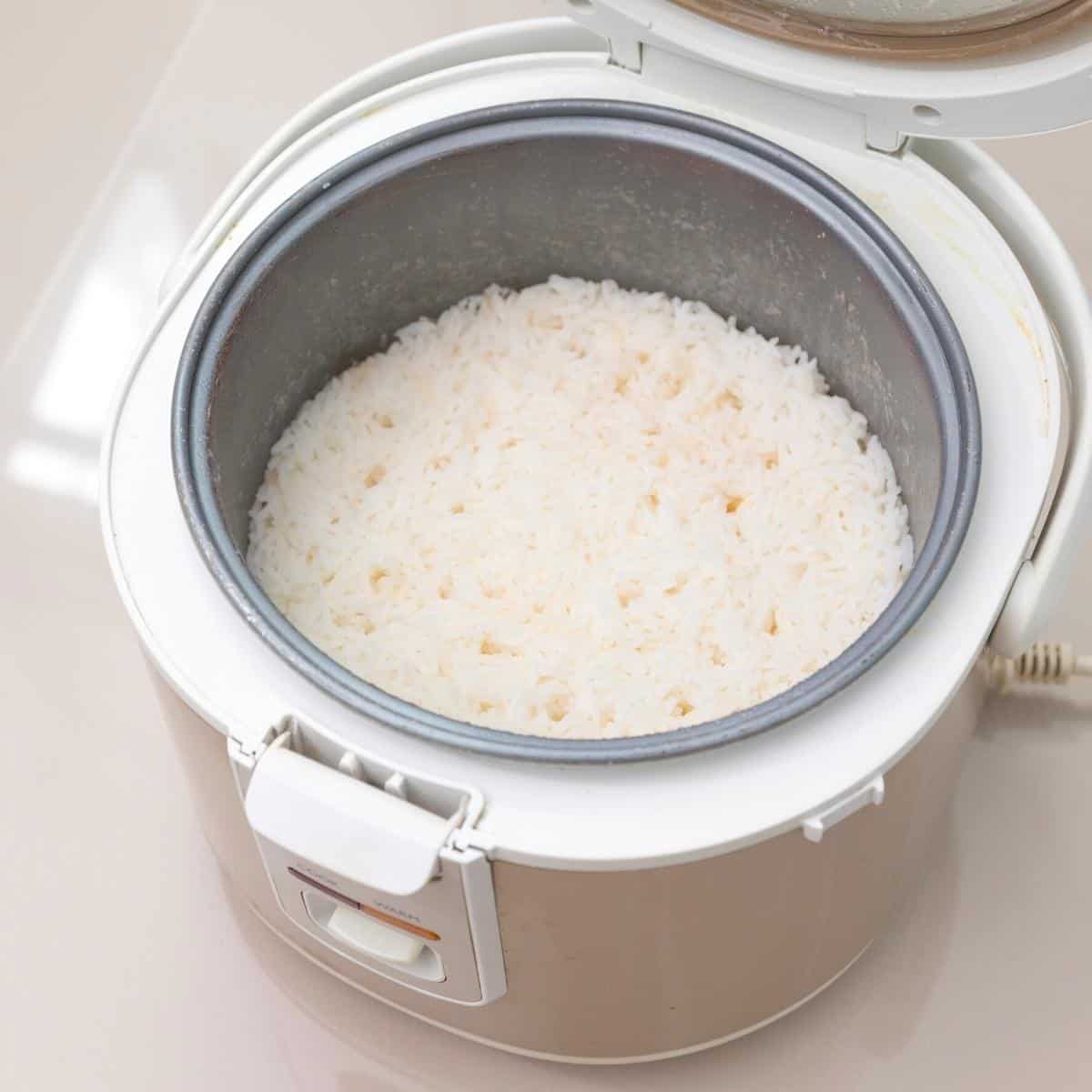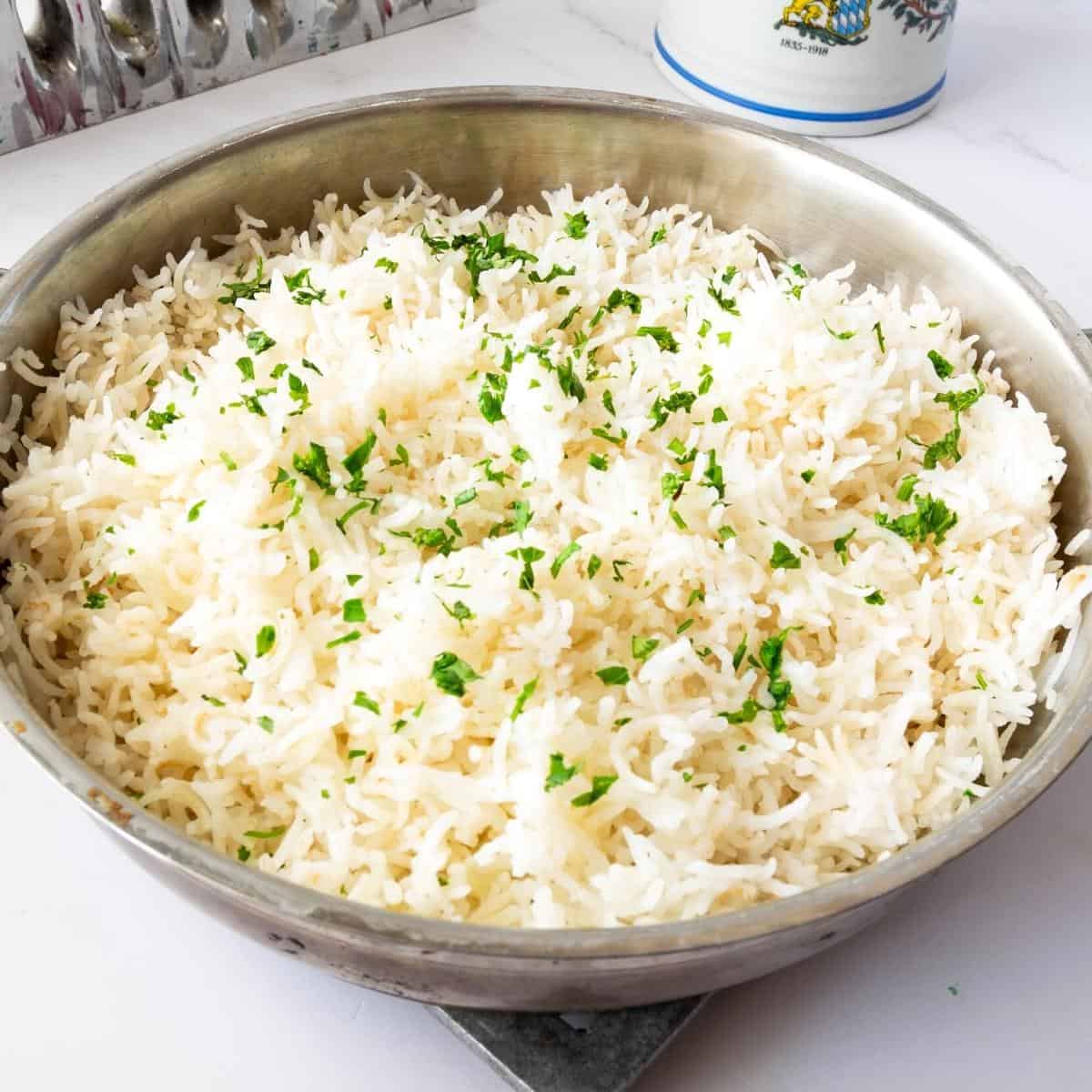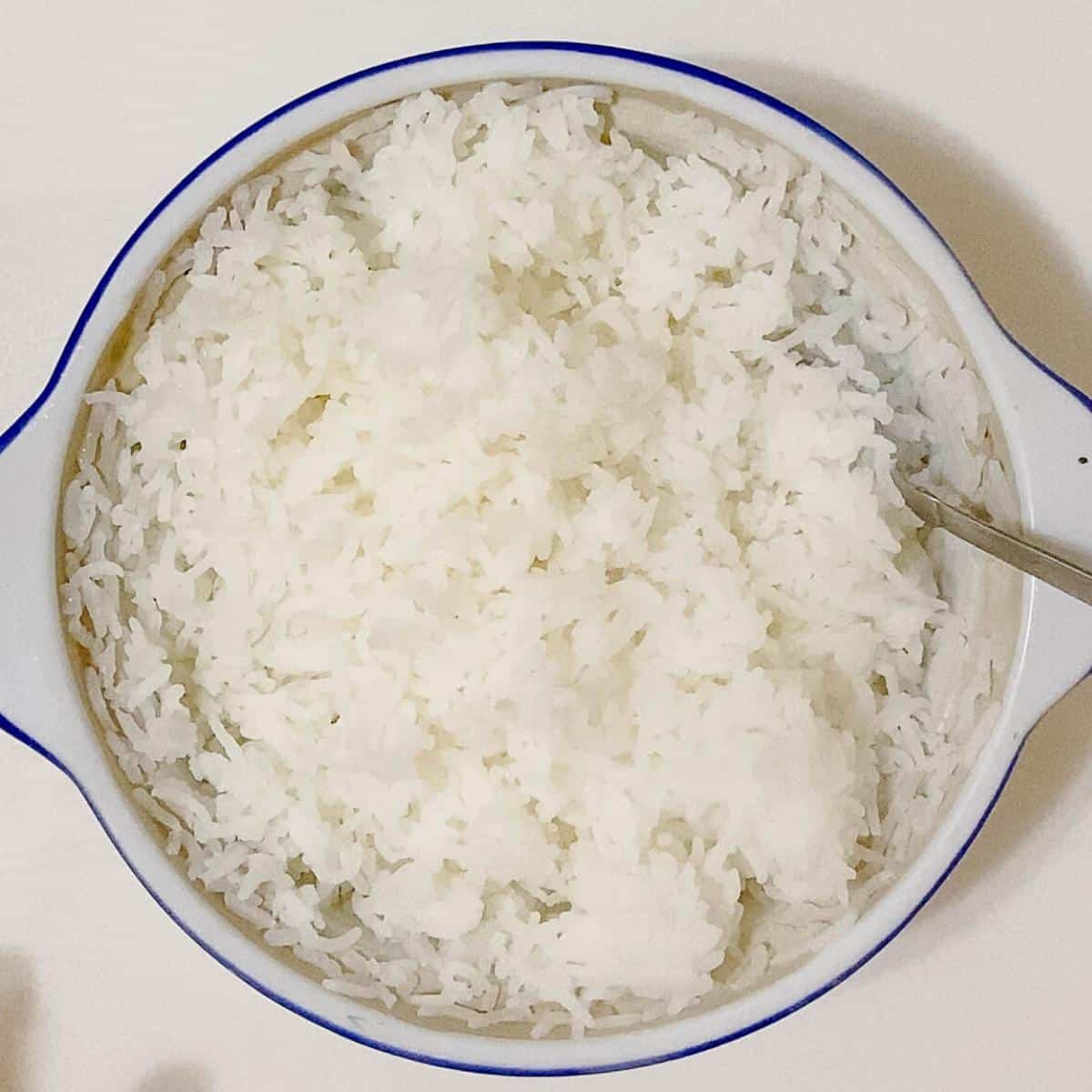Rice is a staple food in many countries, and many varieties of rice are available. Basmati is one of them.
Basmati rice comes in both white and brown varieties. It has a delicate flavor and aroma. In fact, the name basmati means ‘full of aroma’ in Hindi. ‘Bas’ means ‘aroma’ and ‘mati’ means ‘full of’ hence the name basmati. It is grown in the north of India, mainly the foothills of the Himalayas (often the reason why it’s called Indian basmati rice) and parts of Pakistan and Nepal.
Although basmati rice cooks much faster than regular rice and has a mild, nutty flavor, the first thing many people notice is how light and fluffy it is. Also, it is less sticky than other types of rice. And when cooked right, you can almost count each grain separately.
Back in the old days, rice was cooked in a pot of boiling water and then drained. As a result, a lot of the nutrients got washed away in the water. But there are many better ways to cook basmati rice. Today, I show you 5 easy methods that are all simple and fairly quick.
Why cook basmati rice?
Cooking rice should’t be complicated and basmati is the perfect rice to make if you are a novice or seasoned cook. The long grain rice is not just pretty and impressive to look at it is also less sticky, which means it can be used for many meals not just Indian food. A well cooked bowl of rice should be soft, fluffy and of course al dente. Basmati can give you that perfectly every single time. Below are the cooking time for white basmait (not brown rice). Stove – 15 mins with 10 mins rest Microwave – 25 mins with 5 mins rest Instant pot (electric pressure cooker) – 5 minutes with 5 mins rest Pressure cooker (traditional stovetop) – 2 whistles + 5 mins rest Slow cooker – 2 hours And any leftover rice will keep in the fridge for a few days. You can also keep rice in the freezer in airtight containers for up to a month.
Ingredients and substitutes
Rice – Basmati is a long grain rice and this method should work for most long grain rice brands. Some brands may need a little more water and a few more minutes depending on if you soak them or not. Salt – Unless you are going to serve this rice with something salty, I do not see why you would not add salt. You can use coarse sea salt or kosher salt. Oil – a little oil goes a long way in coating each grain so it becomes nice a fluffy. Water – Cold water is all you need. Do not use hot or warm water as it can make the rice gummy.
How to cook basmati rice – 5 easy methods
Rinse and soak rice
Rinse – Measure the rice in a large bowl. Fill with water at least 2 inches more than the rice. Swirl the water around and gently rub the rice with your hand. The water will become very cloudy. Drain the water and repeat the process at least 3 times more or until the water is clear. Drain well.Pro tip – Rinsing the rice will wash away the starch and reduce stickiness. However, if you purchase pre-washed rice you can skip the rising process. Soak – Place the rice in a large bowl and fill it with clean water, at least about 2 inches more than the rice. Leave to soak for 30 minutes. After 30 minutes, drain the rice and cook using your preferred method.
Stovetop
In a saucepan over medium heat, add the soaked and drained rice, salt, oil, and water. Stir to combine. Bring to a boil. As soon as you see bubbles around the edges of the pan, turn the heat to a low simmer. Cover the pot and cook on low for 15 minutes.Pro tip – You do not want the water to come to a rolling boil. Just as long as you see bubbles around the edges turn the heat to a low simmer. Otherwise, too much moisture will evaporate making the rice dry. Once the 15 minutes are up, turn the heat off and leave the rice to rest for an additional 5 to 10 minutes. Open the lid and fluff the rice with a fork.Pro tip – Letting the rice rest will help excess moisture evaporate and make the rice fluffier.
Microwave
In a large microwave-safe bowl, add the soaked and drained rice, salt, oil, and water. Stir to combine. Cover the bowl with plastic wrap and make 3 to 4 holes with a knife. These will help steam escape during cooking.Pro tip – The water in the rice will rise up so it is best to cover with plastic instead of a lid. Cook in the microwave at 50% power for 25 minutes. When done, open and fluff the rice with a fork.
Instant pot (electric pressure cooker)
In the inner bowl of an instant pot (IP), add the soaked and drained rice, salt, oil, and water. Stir to combine. Close the IP and seal the vent. Cook on high pressure for 5 minutes. When the beeper goes off, let the pressure naturally release for 5 minutes. After 5 minutes, release any remaining pressure manually. Open the IP and fluff the rice with a fork.
Pressure cooker (stovetop)
Add the soaked and drained rice, salt, oil, and water to the pressure cooker pot. Stir to combine. Close the lid with the whistle. Cook on medium-high heat for two whistles. After the first two whistles, turn the heat off and let the pressure naturally release for 5 minutes. Then, open the cooker and fluff the rice with a fork.
Slow cooker
Add the soaked and drained rice, salt, oil, and water to the slow cooker pot. Stir to combine. Cook on low for 2 hours until tender. When done, fluff the rice with a fork.
Rice cooker
Add the soaked and drained rice, salt, oil, and water to the inner pot of the rice cooker. Stir to combine. Close the lid and turn the cooker on. The rice will start cooking automatically. When done, the cooker will switch from on to warm.Pro tip – If your rice cooker has more than one settings, read the manual to choose the right program for cooking desired rice. Rest the rice for 10 minutes. Then, fluff with a fork. Keep the lid closed so the rice will continue to keep warm.
How to cook brown basmati rice
Strangely, cooking brown basmati is not the same as cooking other brands of brown rice. In fact, it’s much easier and the results are very similar to white basmati. Therefore, brown basmati rice can also be light and fluffy if cooked correctly. While I have given you a few methods to make white basmati, the best way to make brown basmati is the stovetop. It makes the rice soft yet al dente, which is not sticky or gummy. I notice the microwave, as well as the instant pot, does have not produced the best results for me yet.
Rise and soak the brown basmati for 30 minutes the same way as we did the white basmati rice. In a saucepan over medium heat, add the soaked and drained brown rice, salt, oil, and water. Stir to combine. Bring to a boil. As soon as you see bubbles around the edges of the pan, turn the heat to a low simmer. Cover the pot and cook on a low simmer for 25 minutes.Pro tip – You do not want the water to come to a rolling boil. Just as long as you see bubbles around the edges turn the heat to a low simmer. Otherwise, too much moisture will evaporate making the rice dry. Once the 25 minutes are up, turn the heat off and leave the rice to rest for an additional 10 minutes. Open the lid and fluff the rice with a fork.Pro tip – Letting the rice rest will help excess moisture evaporate and make the rice fluffier.
Variations
Broth – Replace water with chicken or vegetable broth and replace the oil with a tablespoon of butter. When done, add a generous helping of chopped parsley, cilantro, or green onions. Pilaf – A simple way to add more to your rice is to add some veggies. Try my vegetable pilaf, which uses the stovetop method with chopped veggies. Kids’ favorite rice. Fried rice – While fried rice is usually made with leftoer Jasmin rice, don’t stop yourself from using leftover basmati rice. It’s absolutely delicious. Whole spices – Simple whole spices like cardamom pods and cinnamon sticks, along with a few bay leaves enhance the flavor. Jeera rice – You probably saw this at some restaurant. Saute 1/2 cup onion, 1/2 tsp garlic, and 1/2 tsp of cumin in the oil before adding the rice. Then, cook as above. Finish with chopped cilantro. Saffron rice – Add a few stands of zaffran or saffron when cooking the rice for both color and flavor.
What do you serve with basmati rice?
Chicken Curry, Indian Lamb Curry, Slow Cooked Beef Curry Meatball Kofta Curry Chickpeas Curry – Channa Masala Easy Prawn Curry Lentil Chicken Curry or Spinach Tofu Curry Black Beans Curry, Kidney Bean Coconut Curry See all Indian recipes
More rice recipes
Rice Pilaf or Chicken with Rice Pilaf The BEST Fried Rice Turmeric Rice with Chicken and Peas Chicken and Rice Skillet Coconut Turmeric Rice Shrimp with Rice Quick One-Pot Vegetable Rice See all rice recipes
Frequently asked questions
Troubleshooting
Burnt rice – Too little water or too high heat. Water overflowed during cooking – The best way to cook rice on the stovetop is on a low simmer. An overflowing pot means the heat is too high causing the water to overflow. This could result in undercooked, hard or even burnt rice. Undercooked rice – Not enough water and not enough time for cooking. Soggy or gummy rice – Too much water in the pot causing the rice to become sticky.
You may also like
Did you LIKE this recipe? Save it for later. You can find my recipes on Pinterest. Follow me on Facebook, Twitter, and Instagram.Subscribe, and I’ll send you new recipes right to your inbox. Thank you for sharing - Save for later
